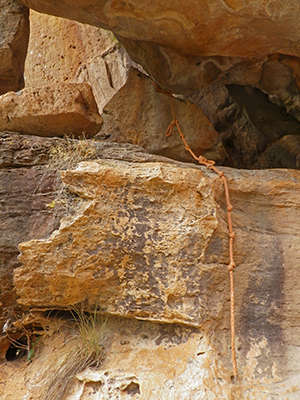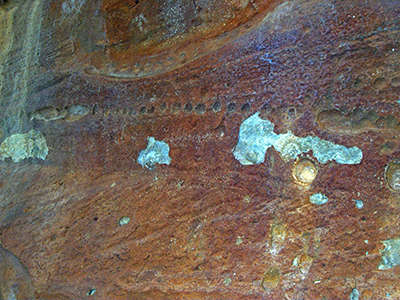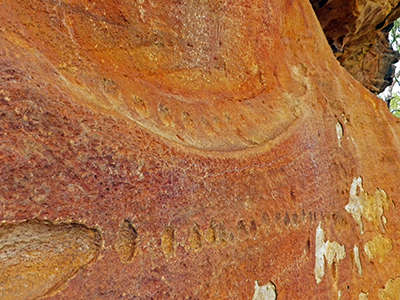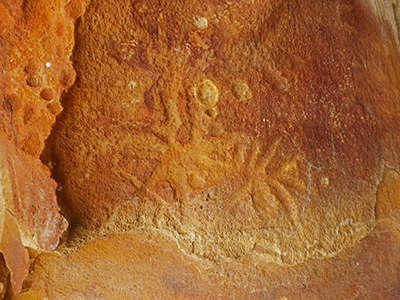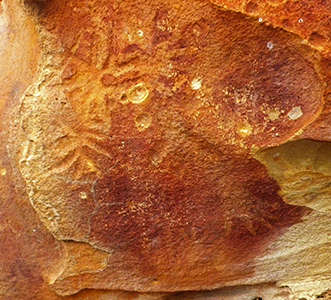Back to Don's Maps
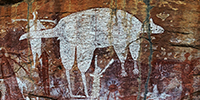 Back to Australian rock art and other Oz sites
Back to Australian rock art and other Oz sites Guardian Place, Yam Camp, Shepherd Creek Secret Place, and Emu Dreaming Galleries - Aboriginal Rock Art sites in Northern Queensland

Photo: © Monique Larrey
The excellent photographs of Guardian Place, Yam Camp, Shepherd Creek Secret Place, and Emu Dreaming Galleries on this page are from Leo Dubal, www.archaeometry.org
The rock art of Guardian Place, Yam Camp, Shepherd Creek Secret Place, and Emu Dreaming Galleries consists of paintings of Quinkan figures, spirit figures, humans, paintings based on yams, a wallaroo and fruit bats, as well as cupules and other engravings in the sandstone.
Guardian Place Gallery
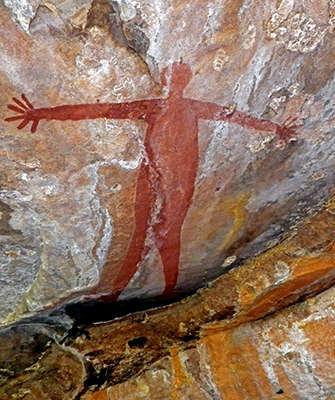
Anthropomorph. This painting appears to have been covered at least partly by calcite. There are six fingers on the right hand, and possibly seven on the left.
Matt Trezise's comments:
Benign looking male with five left foot toes, six on the right foot, six fingers on the right hand, and seven fingers on the left. This is of the genre we call 'guardians', depicted without penis as is common in this genre.
The head is rounded, and is attached to a neck on shoulders. No eyes are visible, and the whole has been outlined in white ochre and infilled in red ochre.
Photo: © Leo Dubal
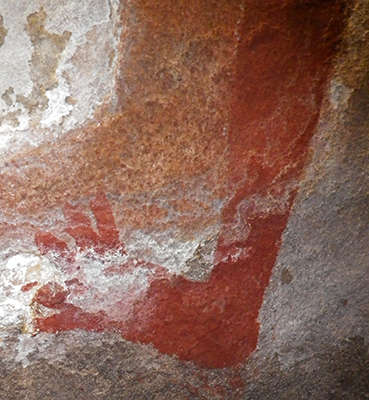
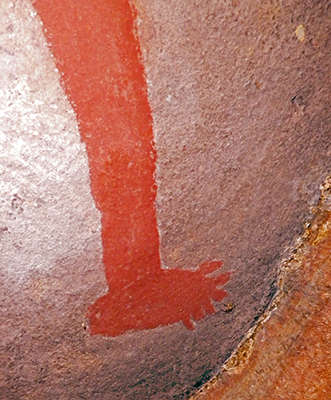
The left foot of the figure above (left) has five toes indicated.
The right foot (right) has six toes, and the heel is somewhat exaggerated in size.
Photo: © Leo Dubal

Negative hand stencil in red ochre, more carefully done than most.
Photo: © Leo Dubal
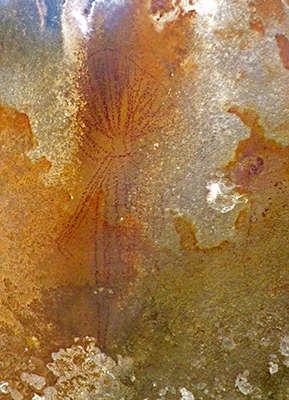
This is a very important drawing of a spirit figure, apparently done with a solid piece of red ochre or haematite, rather than as a painting.
The head itself is small, insignificant, and barely shown, but the headdress is huge.
There has been some spalling of the rock surface, but not enough to significantly damage the image.
It is important to notice the stripes which make up the infill of the figure, and the massive headdress shown.
This is an image meant to convey powerful magic.
Matt Trezise's comments:
This linear figure is quite unusual. - a drawing, not a painting, done with a piece of ochre used like a crayon, sketched quickly and confidently - the headdress places it in the genre of older figures we refer to as 'ancestral beings' - but not obviously a male yam ancestor.
Photo: © Leo Dubal
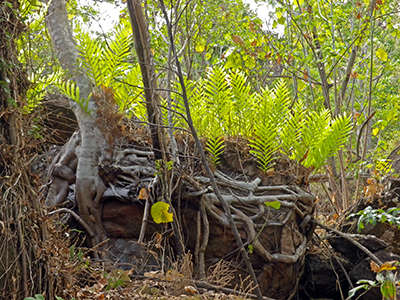
A native fig tree, showing the characteristic aerial roots covering the rock on which it stands, with pioneer species ferns on the rock as well.
Photo: © Leo Dubal
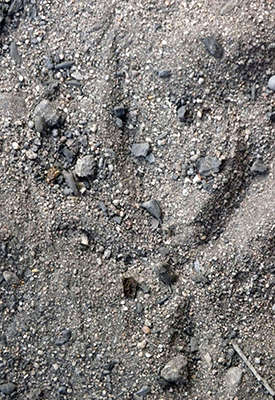
Track of an emu recently left in coarse sand and gravel.
Photo: © Leo Dubal
Yam Camp Gallery
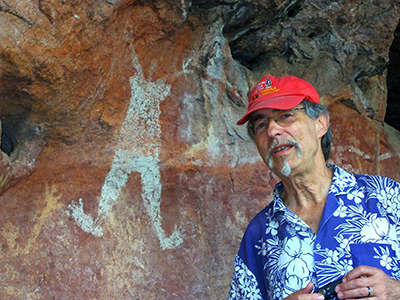
M. Dubal in front of a white ochre female figure, with stick arms and fingers, and huge feet.
Photo: © Monique Larrey

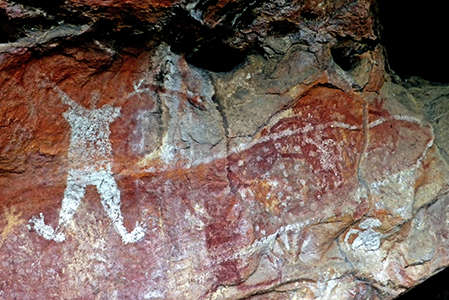
The white ochre female figure above, in context on the panel. It is unclear what the large object outlined in white ochre, infilled in red ochre, and with spots of white on it, is meant to depict.
Below and overlying this object is a red figure of what may be a female with widely splayed legs, as well as two negative hand stencils in white ochre, and what may be a small Quinkan figure in white ochre.
Photo: © Leo Dubal
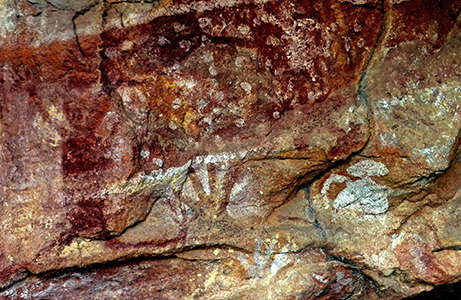
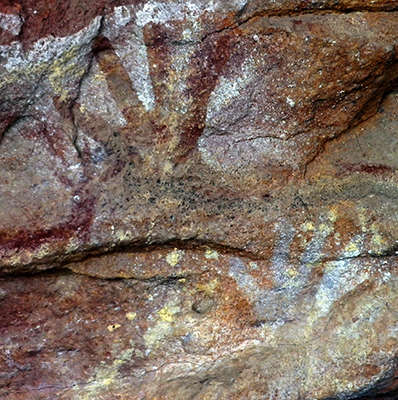
Close up of part of the panel above. Here it is more obvious that the upper negative hand stencil is in white ochre, while the one below appears to have received a coating of white ochre first, with a brown negative stencil placed on this white background, although it might simply be a positive hand print on a brown background.
Note also the partly obliterated white ochre rounded quinkan figure on the bottom right of the left hand image.
Photo: © Leo Dubal
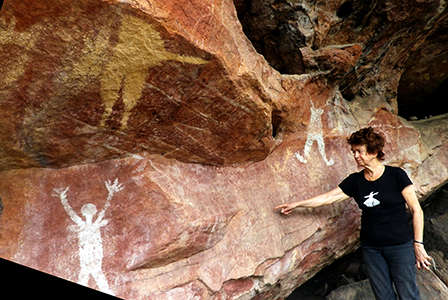
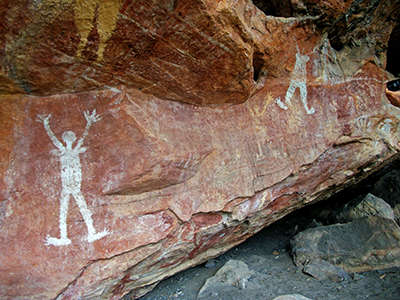
Complete panel, with two white female figures, a yellow ochre figure between them, all in the "surprised" position which may denote a spirit or ancestor figure. There are numerous figures which are now hard to interpret on this panel.
At many aboriginal sites, some panels are used over and over again, with previous images erased or painted over, as though the act of painting is the important part, the art work which results is secondary, or at least not worth preserving.
Photo: © Leo Dubal

The yellow ochre figure in the 'surprised' position is quite weathered.
Unusually, the figure continues (the right arm and hand) on another section of the rock at right angles to the main panel.
Photo: © Leo Dubal
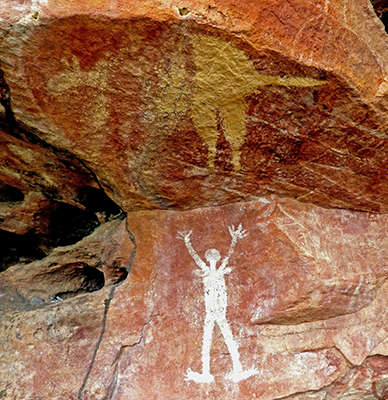
Here we can see, at the left hand end of the panel, the white ochre female figure, with a wallaroo in yellow ochre on the overhang above.
Water drainage from the wall above has trickled over the edge and washed away part of the wallaroo image.
Photo: © Leo Dubal
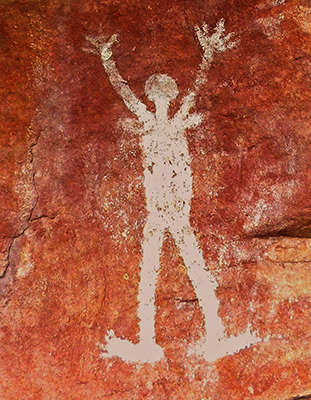
This is the white ochre female figure.
The spread breasts are small, the spread fingers are only roughly done, and the feet are much larger than natural size. This is interpreted as a young female human.
Photo: © Leo Dubal

This is a most unusual panel, with geometric designs rather than human, spirit, or animal figures.
Photo: © Leo Dubal
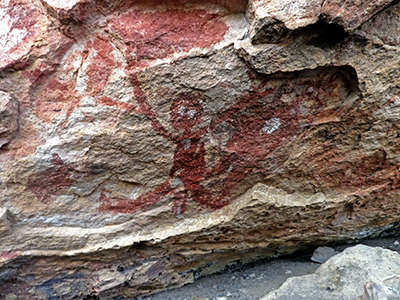
This male spirit figure looks particularly malevolent. The arms and legs are curved. There is obviously much symbolism here, but it is difficult to work out what it is meant to convey. It would be wonderful to be able to talk with the artist about this figure.
It appears to be waving a large piece of bark or hide in its right hand.
Photo: © Leo Dubal

The spirit figure in red on the left has an elaborate headdress. The arms are not shown with hands.
Photo: © Leo Dubal
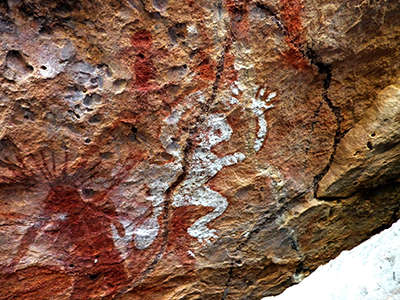
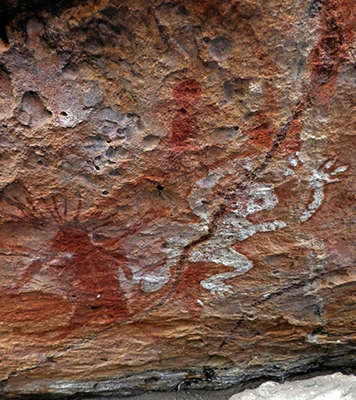
To the right of the spirit figure in red is what appears to be a Quinkan figure in white ochre, outlined in red. The crouching, curved, squat shape indicates that it is an evil, frightening figure.
Photo: © Leo Dubal
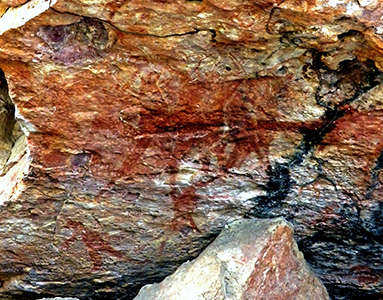
The anthropomorphic figures in this complicated, layered image are difficult to interpret.
Photo: © Leo Dubal
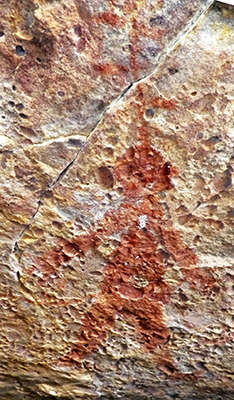
The figure at the bottom left of the panel above has been completed on a pockmarked surface, and is of a dumpy, child like anthropomorphic figure with what looks like a complicated headdress, but is in fact a yam vine.
Matt Trezise's comments:
This figure with a yam vine growing from the head has no penis, but is nevertheless a male figure.
Photo: © Monique Larrey
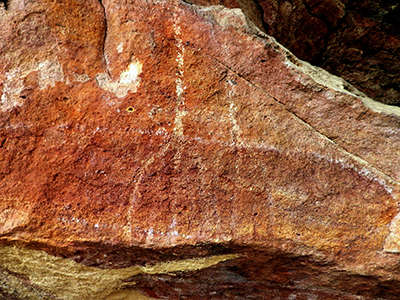
These figures may be stick figures of males, showing only their curved legs, bodies represented by a single line, and penises.
Or they may be nothing of the kind! They look more like three pronged hay forks than anything else.
Photo: © Leo Dubal
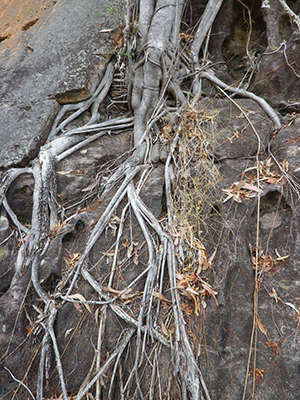
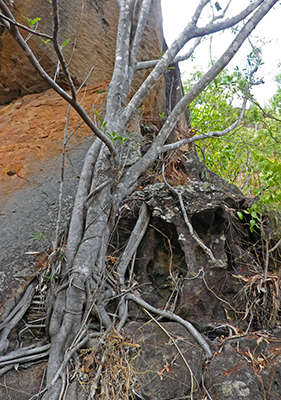
Native Fig Tree. The seeds are dropped by birds on rocks or trees, the seeds germinate and send down adventitious roots looking for food and water. Some species then grow so much that if they start out on a tree branch, they eventually surround the original tree and kill it, leading to their common name of Strangler Figs.
Photo: © Leo Dubal
Shepherd Creek Secret Place Gallery
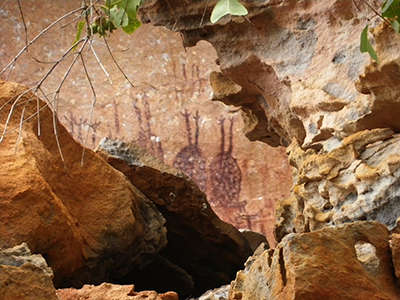
Panel, partly obscured, of fruit bats/flying foxes. This is the first glimpse of the secret place from the outside.
Photo: © Leo Dubal
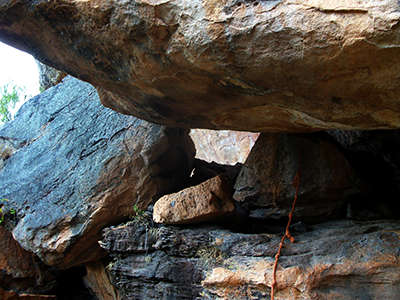
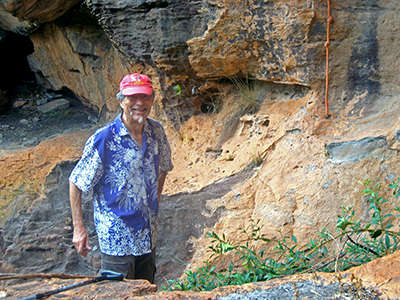
Access to the next gallery was gained by pulling oneself up a steep incline on a rope.
M. Dubal decided against it!
Photo: © Monique Larrey

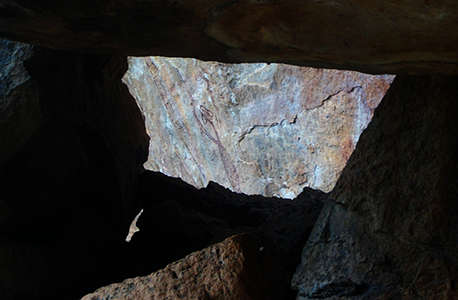
The rope allowed visitors to haul themselves up to the next gallery, with a tantalising glimpse of a Quinkan figure in the gap between the rocks of the ascent.
Photo: © Leo Dubal

This Quinkan figure is a 'good' one, with elongated body and arms.
Photo: © Leo Dubal
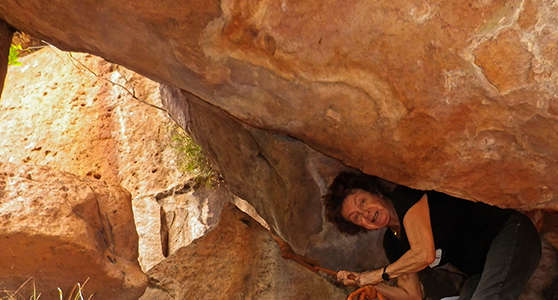
Access required some flexibility!
Photo: © Leo Dubal
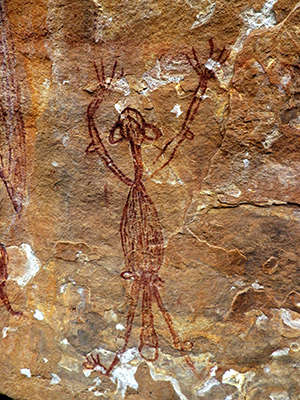
The full Quinkan figure shows the outsize ears (leading to the false impression in less detailed depictions of a mushroom shaped head), as well as very long fingers, knobs on the elbows, knees and hips, and a very large penis with an enlarged glans.
As with many other figures, this Quinkan figure has some of the attributes of a yam, including an elongated, oval body (denoting a 'good' spirit as opposed to an 'evil' one) infilled with stripes.
Photo: © Monique Larrey

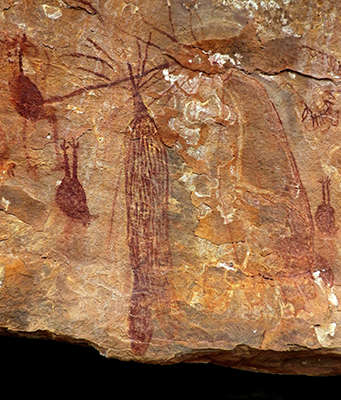
Yams are a very important feature of many of the paintings and drawings in this area, with many objects taking on the features of a yam. These appear to represent just yams.
Yams were obviously very important to the lives of the artists, both as a food and as a spiritual object.
Photo: © Monique Larrey

The full panel. Here we can see at least three fruit bats/flying foxes hanging upside down, two yams, the Quinkan already referred to, a long, tall anthropomorphic figure, and a strange complex figure composed of several yams.
In addition there is a large oval object with an almost straight base, from which project several oval shapes. It is almost like a gigantic footprint. Close by are some twisted lines in dark ochre with lines crossing the main meandering line.
Photo: © Monique Larrey
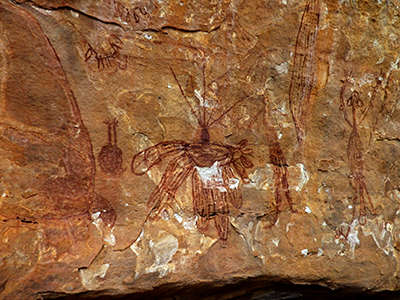
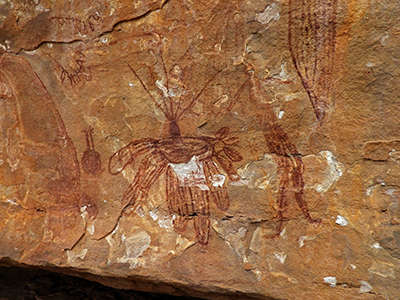
Closeup of the complex central yam figure.
It is not symmetrical, and has five small projections on one side, and two, perhaps three, projections on the other, with what may be two legs in the form of yams, projecting downwards.
Photo: © Monique Larrey
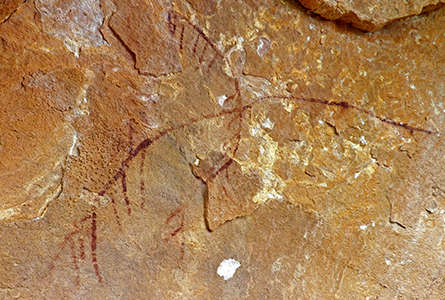
Closeup of a four armed, branched figure.
Photo: © Monique Larrey
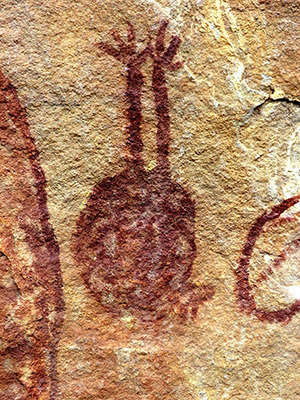
Hanging flying fox. They must have been a valuable resource for the Aborigines of the area - a food larder, with large quantities of food hung up ready to take away!
Even today in some areas of Australia there are flocks of many thousands of these bats which roost in the same spot each night after spending the day spread out in the local forests, feeding.
This image of a lone flying fox is in between the many branched yam figure and the large oval object.
Photo: © Monique Larrey

On hot days, flying foxes dip their bellies in water to cool down.
Photo: © Nick Edards
Source: http://theconversation.com/
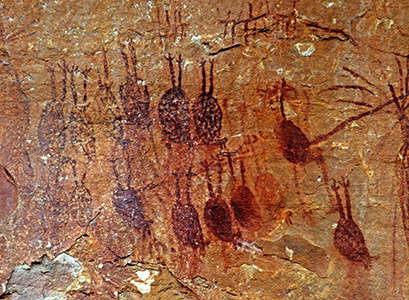

Images of many hanging flying foxes.
Photo: © Monique Larrey
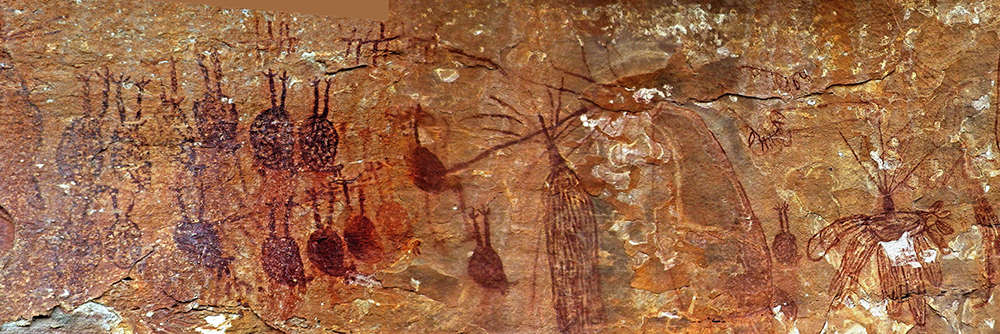
This photomontage allows us to see the relationship between the flying fox images and the rest of the main panel.
Photo: © Monique Larrey

Enigmatic mark in white ochre.
Photo: © Monique Larrey
Approach to Emu Dreaming Gallery

View across the surrounding countryside. This is Jowalbinna cliff seen from outside the secret place, on the way to Emu Dreaming Gallery.
Photo: © Leo Dubal

This is fruit of a plant related to the Quandong. The leaves on this plant are broader than normal for Santalum acuminatum.
Photo: © Leo Dubal
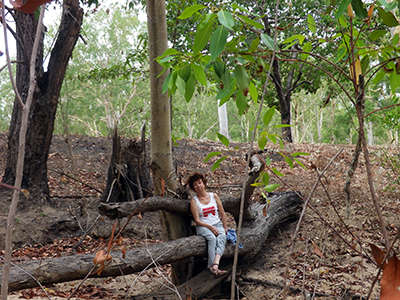

The type of vegetation changes remarkably between the growth on dry ridges and that beside a stream or water hole.
Photo: © Leo Dubal
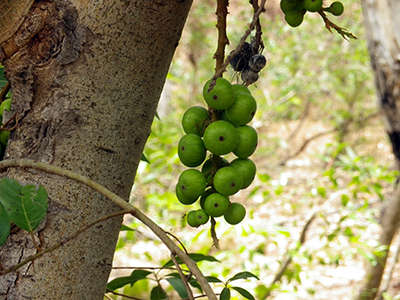
Native figs on a large tree, Ficus racemosa. It is unusual in that its figs grow on or close to the tree trunk, a habit that is termed cauliflory.
Photo: © Leo Dubal
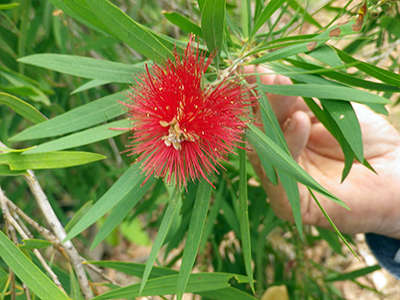
A bottle brush, Callistemon genus.
Photo: © Leo Dubal
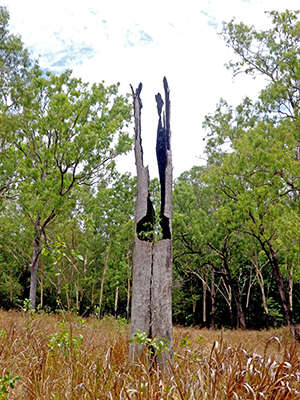
Fires sweep through the Australian bush on a regular basis. This burnt out trunk provides a habitat for many different plants, animals, and bacteria, until it finally falls and rots, becoming part of the humus of the soil.
Photo: © Leo Dubal

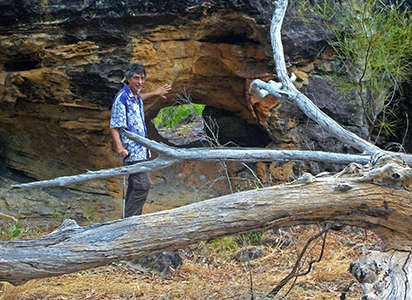
A natural tunnel through the sandstone.
Photo: © Monique Larrey

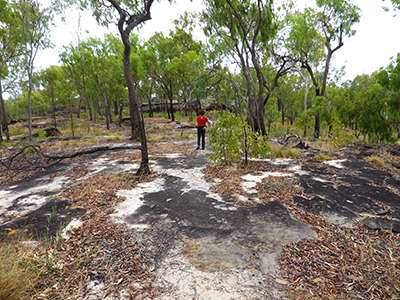
Marsupials, and a very curious natural 'freeway' to the Emu Dreaming Gallery.
Photo: © Leo Dubal
Emu Dreaming Gallery
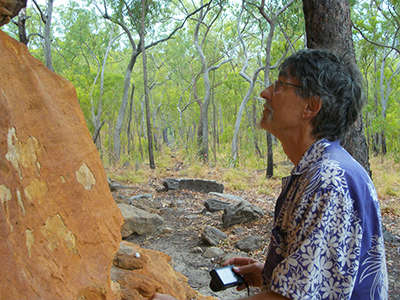
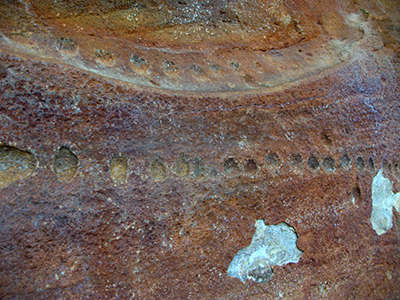
The gallery had many ancient weathered cupules in the surface.
Photo: © Monique Larrey
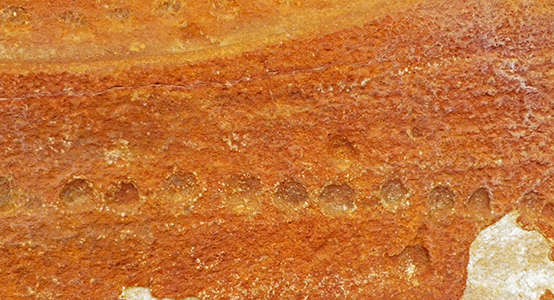
Cupules are the most ubiquitous of all engravings around the world.
Photo: © Leo Dubal
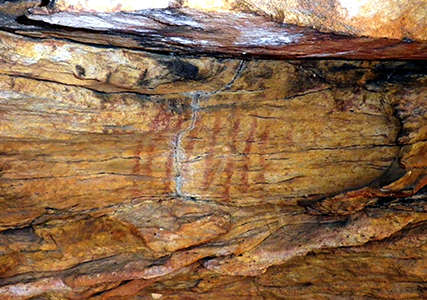
The vertical lines of red ochre in the centre of this image, and much faded red dots on the left are of unknown significance.
Photo: © Leo Dubal
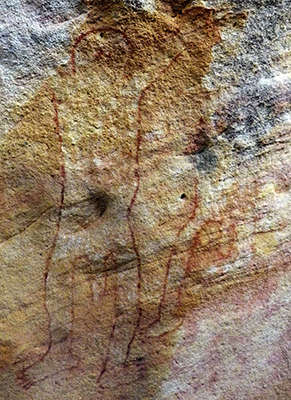
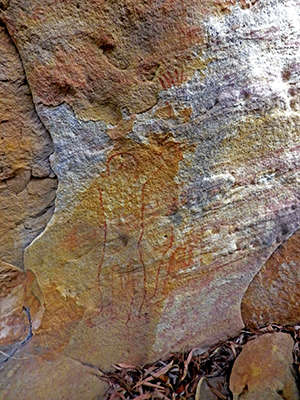
Spirit figures outlined in red ochre, and infilled in white. Both are depicted with very large penises.
The complete figure on the left is shown with a head which arises from the shoulders with no sign of a neck.
Much of the surface of this panel has flaked away. Seemingly disassociated from these figures is what might be a spiked headdress further up the wall.
Photo: © Leo Dubal

Feet of the nearly complete figure are shown drawn in a naturalistic way, but with an extended heel on at least one of the feet.
We can see, however, that the feet are shown turned away from each other in a way that would have been difficult or impossible for a real person to achieve.
Photo: © Leo Dubal
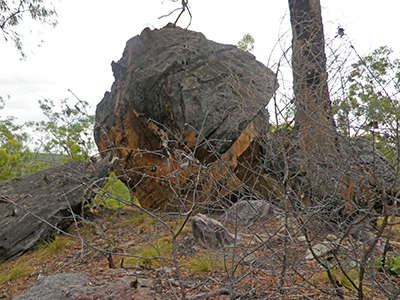
A large boulder which has detached itself from the main outcrop, and has rolled part way down the hill.
Photo: © Leo Dubal
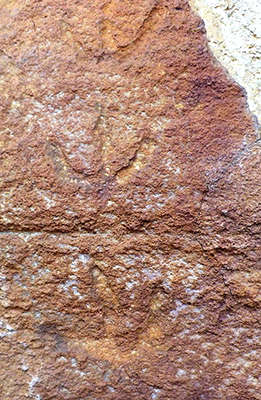

Emu tracks and legs carved into the rock surface. Emus would have been a very important resource for the aborigines of the area, and were relatively easily hunted. Their curiosity was often their undoing.
Photo: © Leo Dubal
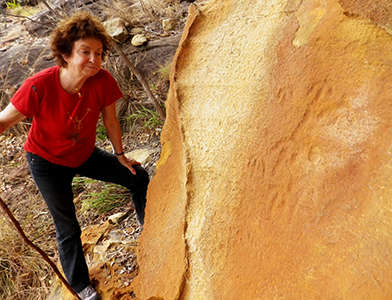
This image shows the carvings above in situ.
Photo: © Leo Dubal
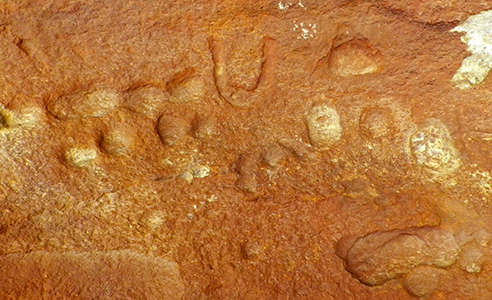
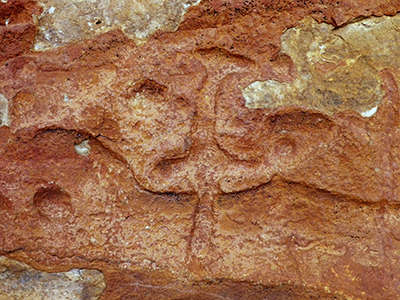
Cupules carved into the sandstone.
On the right the central carving may represent a Quinkan figure, with mushroom shaped head caused by large ears, and a very large penis.
Photo: © Leo Dubal
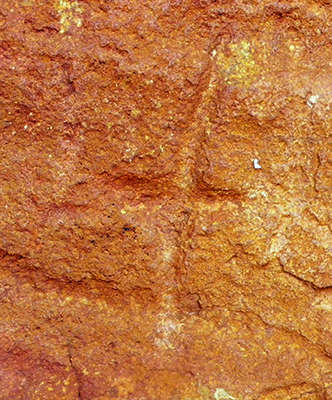
Engraving in the shape of a cross.
Photo: © Leo Dubal
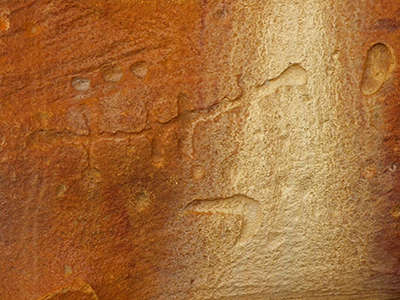

These images are difficult to interpret.
Photo: © Leo Dubal
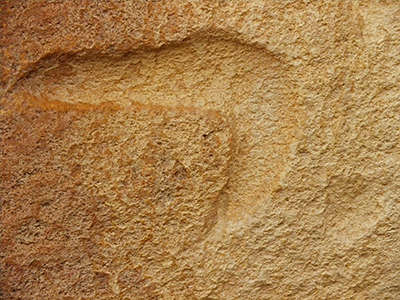
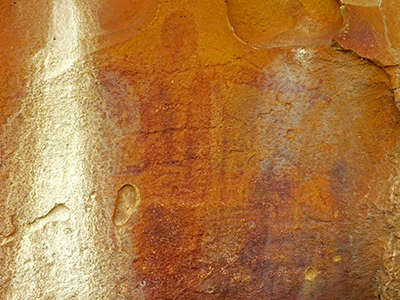
Closeups of some of the images. On the right is the faded image of an anthropomorphic figure in red ochre.
Photo: © Leo Dubal

Many-rayed images carved into the sandstone.
Photo: © Leo Dubal
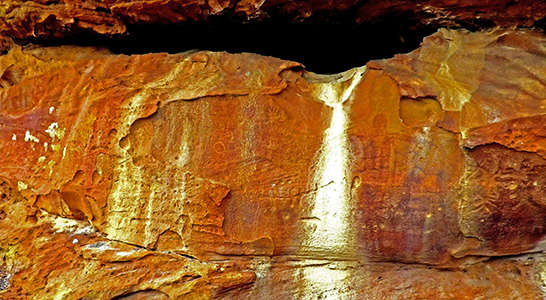
This valuable image puts many of the carvings into their place in the whole panel. The carvings give the impression of being very old.
Photo: © Leo Dubal
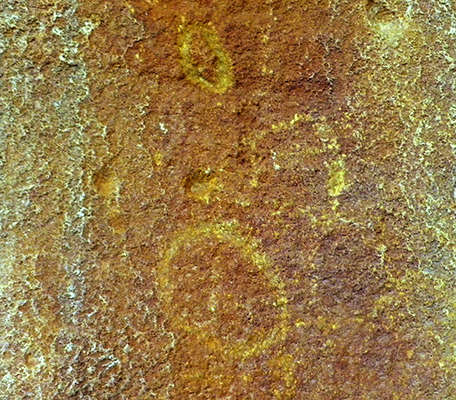
Circles drawn in yellow ochre.
Photo: © Leo Dubal
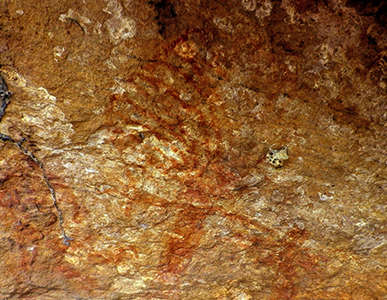
This painting in red ochre appears to be of an anthropomorphic figure with a huge, fantastical headdress.
Photo: © Leo Dubal
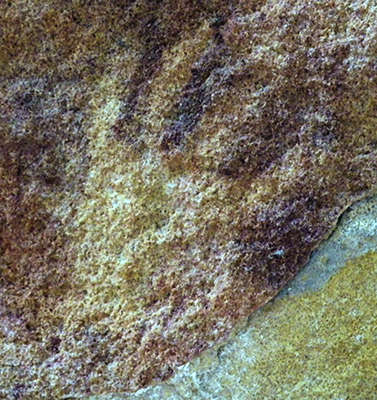
Negative hand stencil in very dark red ochre.
Photo: © Leo Dubal
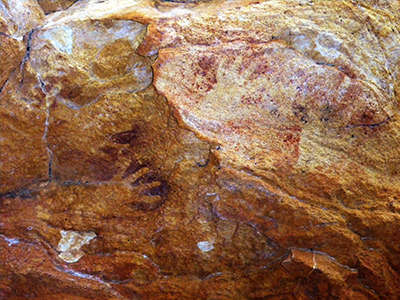
This panel shows a number of hand stencils.
Photo: © Leo Dubal

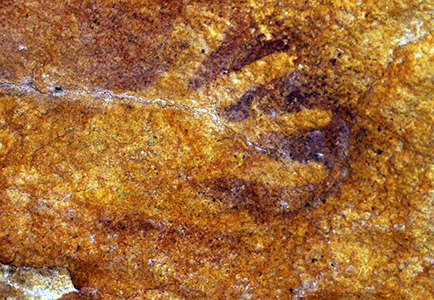
Close ups of some of the hand stencils.
Photo: © Leo Dubal

Hand stencils.
Photo: © Leo Dubal

Map of some of the sites mentioned.
Photo: supplied by Leo Dubal

Map of part of Far North Queensland showing the location of the Laura River rock art sites.
Photo: Pearson (1989)
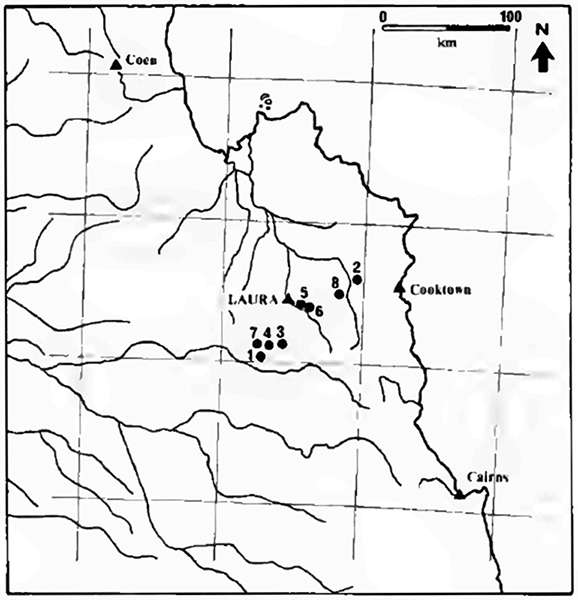
The Laura sandstone belt, showing the location
of some rock art sites.
1 Yam Camp
2 Platform Gallery
3 Magnificent Gallery
4 Sandy Creek
5 Mushroom Rock
6 Early Man
7 Red Bluff
8 Red Horse
Photo and text: David and Chant (1995)
References
- David B., Chant D., 1995: Rock art and regionalisation in north Queensland prehistory, Memoirs of the Queensland Museum, Brisbane 1 August 1995 Volume 37 Part 2 Hamlyn-Harris, Ronald; Queensland Museum
- Harding P., 2002: Outback Australia, Lonely Planet Regional Guides, 2002 - Australia - 496 pp.
- Pearson W., 1989: A Technological Analysis of Stone Artefacts from Yam Camp Surface Scatter and Rockshelter, S.E- Cape York Peninsula, Queensland Archaeological Research, Vol. 6, December 1989
- Sowerby J., Lear E., 1872: Tortoises, terrapins, and turtles drawn from life, London, Paris, and Frankfort, H. Sotheran, J. Baer & co.
